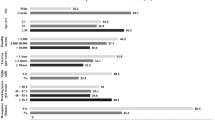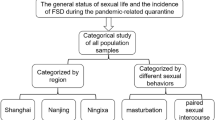Abstract
The prevalence of sexual problems (SP) and sexual satisfaction and their associations with sex-related perceptions and quality of life (QOL) were investigated by interviewing 3257 and 1568 Chinese adults in Hong Kong by a specially designed computerized telephone-interviewing method. SP was prevalent among male (50.9%) and female (54%) respondents; approximately 50% were dissatisfied with their sexual life. Of respondents, 23.9% of men and 5.9% of women perceived sex as important and 52.5% for men and 33.8% of women reported adequate sexual knowledge. The prevalence of SP ranged from 3.4% (pain) to 29.7% (premature orgasm) for men and 6.9% (anxiety) to 24.7% (lack of interest) for women. Prevalence of erectile and lubrication problems were 9.6 and 23.6%, respectively. Sex-related knowledge, perceived importance of sex, perceived physical health status, sexual satisfaction were predictors of SP. Gender differences and strong cultural influences appear to exist. Moreover, SP and sexual satisfaction were associated with mental health and vitality QOL and overall life satisfaction.
This is a preview of subscription content, access via your institution
Access options
Subscribe to this journal
Receive 8 print issues and online access
$259.00 per year
only $32.38 per issue
Buy this article
- Purchase on Springer Link
- Instant access to full article PDF
Prices may be subject to local taxes which are calculated during checkout
Similar content being viewed by others
References
Astbury-Ward E . The erectile dysfunction revolution. Nurs Stand 2000; 15: 34–40.
Laumann EO et al. Sexual problems among women and men aged 40–80 y: prevalence and correlates identified in the Global Study of Sexual Attitudes and Behaviors. Int J Impot Res 2005; 17: 39–57.
Meston CM, Derogatis LR . Validated instruments for assessing female sexual function. J Sex Marital Ther 2002; 28 (Suppl 1): 155–164.
Polonsky DC . Sexuality in women. Harv Rev Psychiatry 2001; 9: 310–317.
Laumann EO, Paik A, Rosen RC . Sexual dysfunction in the United States: prevalence and predictors. JAMA 1999; 281: 537–544.
Nathan SG . The epidemiology of the DSM-III psychosexual dysfunctions. J Sex Marital Ther 1986; 12: 267–281.
Lewis RW et al. Epidemiology/risk factors of sexual dysfunction. J Sex Med 2004; 1: 35–39.
Ansong KS, Lewis C, Jenkins P, Bell J . Epidemiology of erectile dysfunction: a community-based study in rural New York State. Ann Epidemiol 2000; 10: 293–296.
Johannes CB et al. Incidence of erectile dysfunction in men 40–69 years old: longitudinal results from the Massachusetts male aging study. J Urol 2000; 163: 460–463.
Giuliano F, Allard J . Dopamine and male sexual function. Int J Impot Res 2001; 13 (Suppl 3): S18–S28.
Incrocci L, Slob AK, Levendag PC . Sexual (dys)function after radiotherapy for prostate cancer: a review. Int J Radiat Oncol Biol Phys 2002; 52: 681–693.
Jonker-Pool G et al. Sexual functioning after treatment for testicular cancer—review and meta-analysis of 36 empirical studies between 1975–2000. Arch Sex Behav 2001; 30: 55–74.
Kessel B . Sexuality in the older person. Age Ageing 2001; 30: 121–124.
McWaine DE, Procci WR . Drug-induced sexual dysfunction. Med Toxicol Adverse Drug Exp 1988; 3: 289–306.
Michels KB . Problems assessing nonserious adverse drug reactions: antidepressant drug therapy and sexual dysfunction. Pharmacotherapy 1999; 19: 424–429.
Meston CM, Frohlich PF . Update on female sexual function. Curr Opin Urol 2001; 11: 603–609.
Sipski ML, Behnegar A . Neurogenic female sexual dysfunction: a review. Clin Auton Res 2001; 11: 279–283.
Metz ME, Pryor JL . Premature ejaculation: a psychophysiological approach for assessment and management. J Sex Marital Ther 2000; 26: 293–320.
Halvorsen JG, Metz ME . Sexual dysfunction. Part II: Diagnosis, management, and prognosis. J Am Board Fam Pract 1992; 5: 177–192.
Fujisawa M et al. Evaluation of health-related quality of life in patients treated for erectile dysfunction with viagra (sildenafil citrate) using SF-36 score. Arch Androl 2002; 48: 15–21.
Giuliano F, Pena BM, Mishra A, Smith MD . Efficacy results and quality-of-life measures in men receiving sildenafil citrate for the treatment of erectile dysfunction. Qual Life Res 2001; 10: 359–369.
Guest JF, Das GR . Health-related quality of life in a UK-based population of men with erectile dysfunction. Pharmacoeconomics 2002; 20: 109–117.
Litwin MS, Nied RJ, Dhanani N . Health-related quality of life in men with erectile dysfunction. J Gen Intern Med 1998; 13: 159–166.
Wagner G, Fugl-Meyer KS, Fugl-Meyer AR . Impact of erectile dysfunction on quality of life: patient and partner perspectives. Int J Impot Res 2000; 12 (Suppl 4): S144–S146.
Siu SC et al. Prevalence of and risk factors for erectile dysfunction in Hong Kong diabetic patients. Diabet Med 2001; 18: 732–738.
Naya Y et al. Significant decrease of the International Index of Erectile Function in male renal failure patients treated with hemodialysis. Int J Impot Res 2002; 14: 172–177.
Liang CZ et al. Prevalence of sexual dysfunction in Chinese men with chronic prostatitis. BJU Int 2004; 93: 568–570.
Naya Y et al. Preliminary report of association of chronic diseases and erectile dysfunction in middle-aged men in Japan. Urology 2003; 62: 532–536.
Jain K, Radhakrishnan G, Agrawal P . Infertility and psychosexual disorders: relationship in infertile couples. Indian J Med Sci 2000; 54: 1–7.
Lim PH et al. Clinical efficacy and safety of sildenafil citrate (Viagra) in a multi-racial population in Singapore: a retrospective study of 1520 patients. Int J Urol 2002; 9: 308–315.
Lau JT, Tsui HY . Behavioral surveillance surveys of the male clients of female sex workers in Hong Kong: results of three population-based surveys. Sex Transm Dis 2003; 30: 620–628.
Department of Census HKG. Population by ethnicity, 2001. Available at http://www.info.gov.hk/censtatd/eng/hkstat/fas/01c/cd0052001_index.html.
Des J et al. Audio-computer interviewing to measure risk behaviour for HIV among injecting drug users: a quasi-randomised trial. Lancet 1999; 353: 1657–1661.
Shaughnessy JJ, Zechmeister EB . Research Methods in Psychology. The McGraw-Hill Companies, Inc. New York, 1997.
Lau JT, Tsui HY, Wang QS . Effects of two telephone survey methods on the level of reported risk behaviours. Sex Transm Infect 2003; 79: 325–331.
Lau JT, Tsui HY . Surveillance of HIV/AIDS-related attitudes and perceptions among the general public in Hong Kong from 1994 to 2000. AIDS Educ Prev 2002; 14: 419–431.
Lau JT, Tsui HY . HIV/AIDS behavioral surveillance surveys of the cross-border sex-networker population in Hong Kong from 1997 to 2001. Sex Transm Dis 2003; 30: 827–834.
Lau JT, Yang X, Tsui H, Kim JH . Monitoring community responses to the SARS epidemic in Hong Kong: from day 10 to day 62. J Epidemiol Commun Health 2003; 57: 864–870.
Lam CL, Gandek B, Ren XS, Chan MS . Tests of scaling assumptions and construct validity of the Chinese (HK) version of the SF-36 Health Survey. J Clin Epidemiol 1998; 51: 1139–1147.
Rosen RC, Laumann EO . The prevalence of sexual problems in women: how valid are comparisons across studies? Commentary on Bancroft, Loftus, and Long's (2003) ‘distress about sex: a national survey of women in heterosexual relationships’. Arch Sex Behav 2003; 32: 209–211.
Lau JT, Thomas J, Liu JL . Mobile phone and interactive computer interviewing to measure HIV-related risk behaviours: the impacts of data collection methods on research results. AIDS 2000; 14: 1277–1279.
Author information
Authors and Affiliations
Corresponding author
Rights and permissions
About this article
Cite this article
Lau, J., Kim, J. & Tsui, HY. Prevalence of male and female sexual problems, perceptions related to sex and association with quality of life in a Chinese population: a population-based study. Int J Impot Res 17, 494–505 (2005). https://doi.org/10.1038/sj.ijir.3901342
Received:
Revised:
Accepted:
Published:
Issue Date:
DOI: https://doi.org/10.1038/sj.ijir.3901342
Keywords
This article is cited by
-
Hostile and Benevolent Sexism and Attitudes Toward Establishing Consent Among Chinese Men: The Detrimental Role of Token Resistance Beliefs and Binge Drinking
Sex Roles (2022)
-
Is Reproductive Orientation Associated with Sexual Satisfaction Among Partnered U.S. Women?
Archives of Sexual Behavior (2021)
-
Prevalence and correlates of erectile dysfunction in type 2 diabetic men: a population-based cross-sectional study in Chinese men
International Journal of Impotence Research (2019)
-
Predictors of female sexual dysfunction: a systematic review and qualitative analysis through gender inequality paradigms
BMC Women's Health (2018)
-
Understanding the Prevalence of Sexual Dysfunctions in Women: an Evolutionary Perspective
Adaptive Human Behavior and Physiology (2016)



